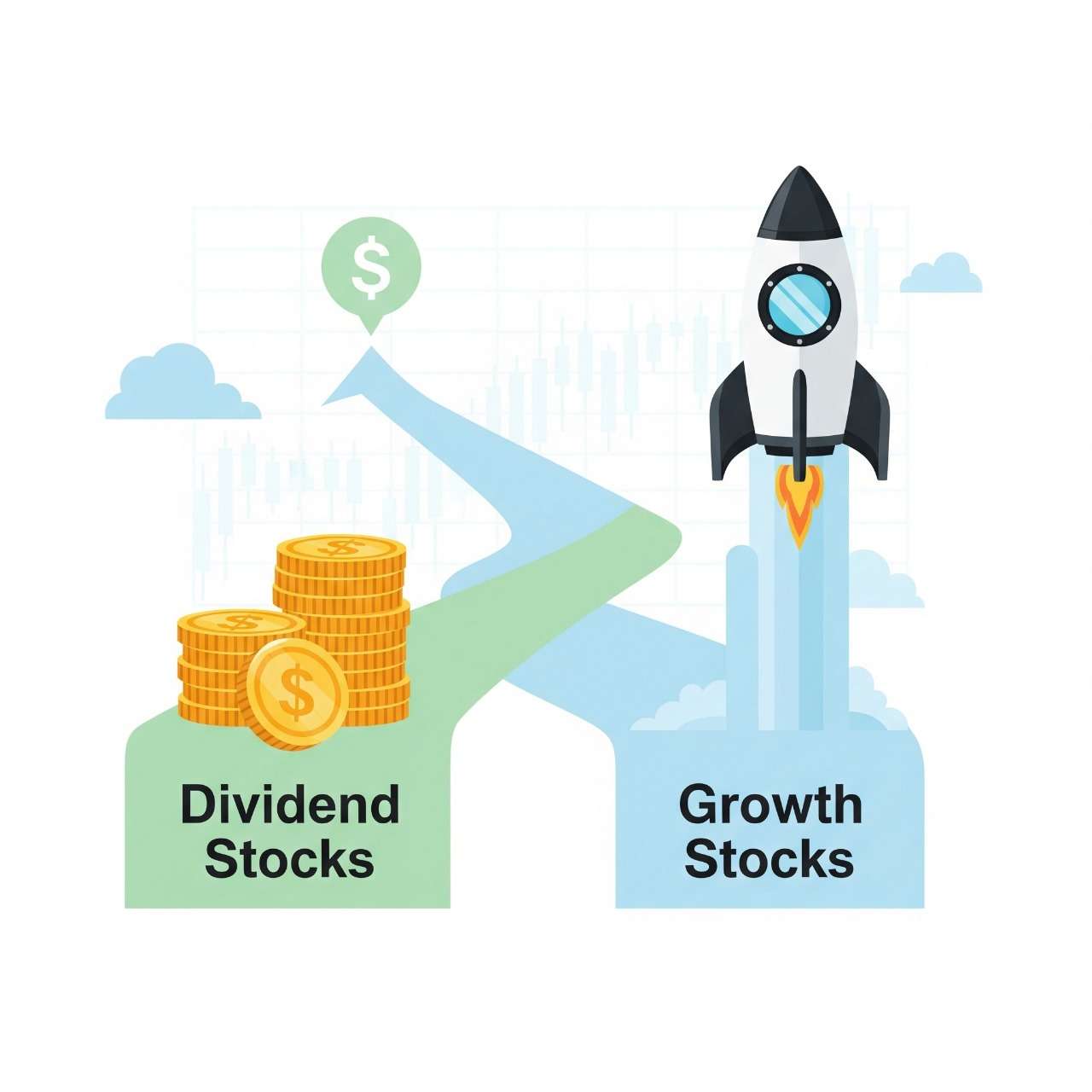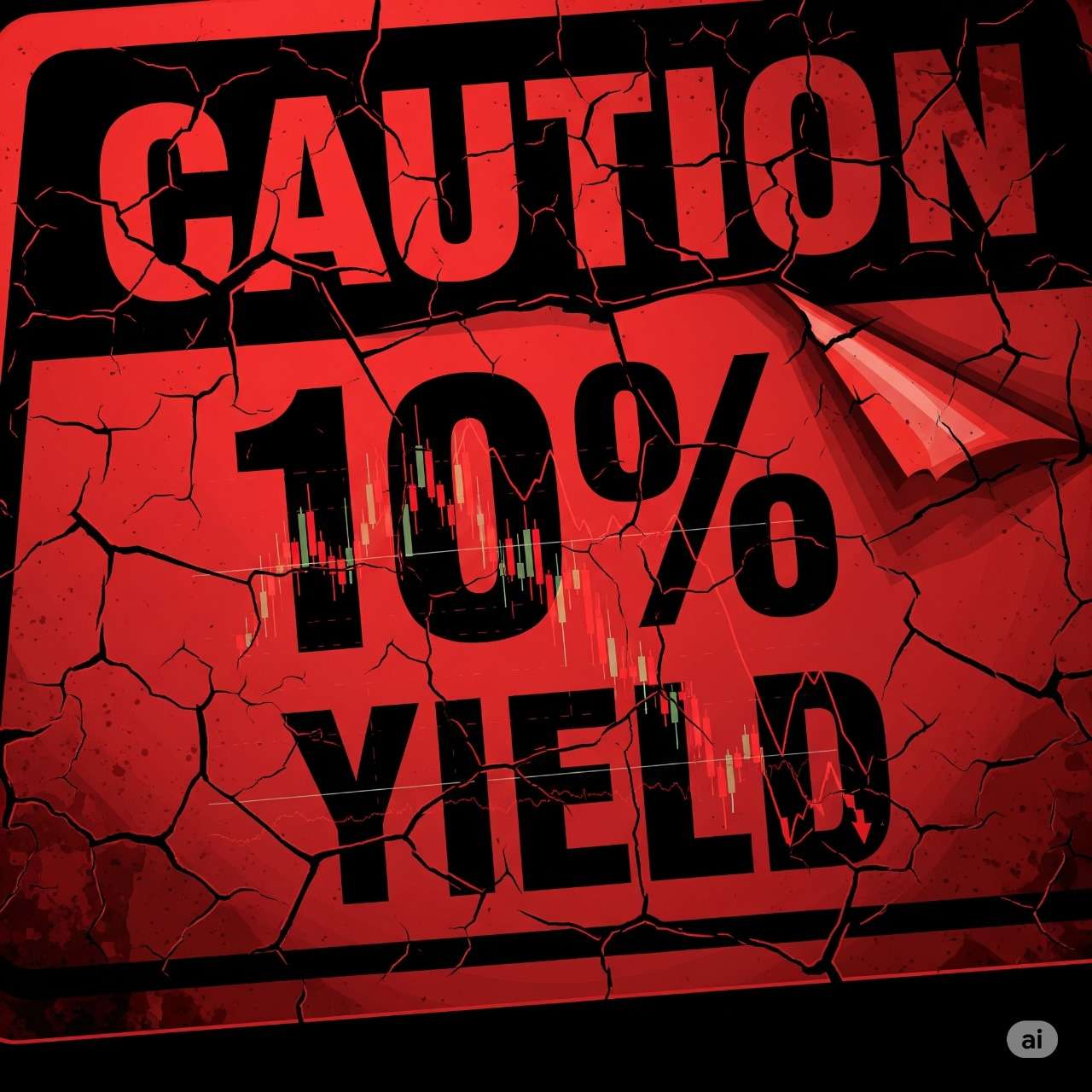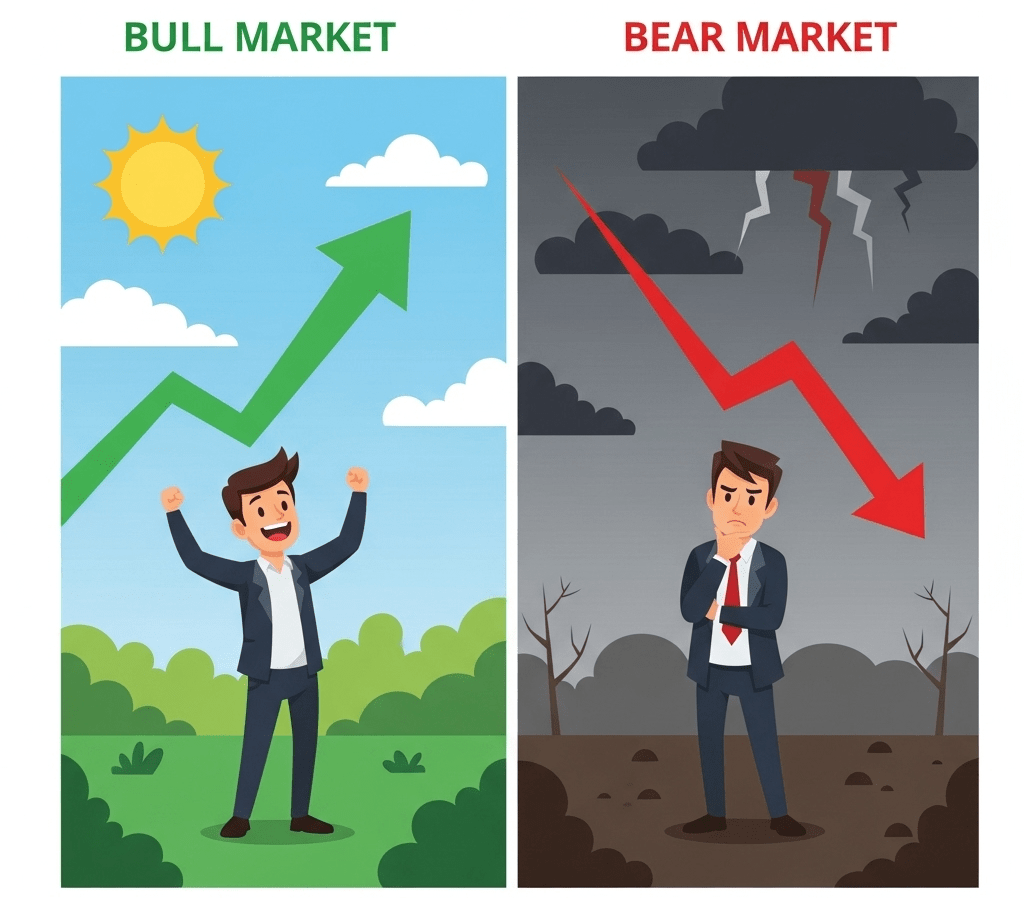- 16 July 2025
- No Comment
- 523
Dividend vs Growth Stocks: The Simple Truth Beginners Need to Know

You’ve probably heard this: Dividend stocks are the “safe and steady” path, while growth stocks are the “get rich quick” rocketship. But what if that common wisdom is dangerously oversimplified? What if both strategies could either build your wealth… or quietly bleed it dry, depending on how you use them?
The truth most investors miss is simpler than you think. Choosing between dividend stocks and growth stocks isn’t about finding the “best” one. It’s about understanding which one aligns with your money goals, your timeline, and your stomach for market ups and downs.
Stick with us as we unpack the real differences, bust common myths, and reveal how these two seemingly opposite strategies might actually work better together. Why does a company like Coca-Cola happily send you cash just for owning its stock, while Tesla keeps every penny? Let’s dive in!
What Are Dividend Stocks? (Your “Reliable Friend”)
Think of dividend stocks like a dependable friend who sends you $20 every month just for being in their life. You didn’t do anything special – they simply appreciate the relationship! That’s essentially how dividend stocks work.
- The Core Idea: When you own shares in a dividend-paying company, the company shares a slice of its actual profits with you, its shareholder. This usually happens every quarter (four times a year).
- The Dividend Yield: This is the key number. If a stock costs $100 per share and pays you $4 in dividends over a year, that’s a 4% dividend yield. It might sound small, but this steady income can be a powerful force over time, often helping your returns outpace inflation.
Who Pays Dividends? The Main Players:
- Real Estate Investment Trusts (REITs): Imagine being a landlord, but without the midnight calls about leaky toilets! REITs own and operate income-generating real estate (apartments, malls, offices). They collect rent and are required to pay out most of their taxable income as dividends. Catch: REIT dividends are often taxed higher than other dividends, and they can be sensitive to economic shifts.
- Consumer Staples Companies: Think Coca-Cola, Procter & Gamble (toothpaste, detergent), or Walmart. These companies sell everyday essentials people need regardless of the economy. People still brush their teeth and buy soda during recessions! This stability often translates into reliable dividends.
- Financial Giants: Big banks (like JPMorgan Chase), insurance companies, and asset managers. They generate steady income from loans, fees, and premiums, allowing them to share profits via dividends.
- Energy Titans: Companies like ExxonMobil or Chevron. They often have high upfront costs (building oil rigs, pipelines) but can generate significant cash flow, especially when energy prices rise, funding substantial dividends.

The High-Yield Trap (A Crucial Warning!): Seeing a juicy dividend yield like 7% or 8% can be incredibly tempting, especially for beginners seeking passive income from stocks. But beware! A sky-high yield is often a red flag. It might mean:
- The company is struggling, and its stock price has crashed (remember, Yield = Dividend / Stock Price. If the price crashes, the yield shoots up even if the dividend stays the same).
- The company is paying out more than it can realistically afford, putting the dividend itself at risk of being cut.
The Takeaway: Don’t chase yield blindly. Focus on finding solid, financially healthy businesses first. The sustainable dividend is a welcome bonus. Best dividend stocks are usually those with a history of stable or growing payouts from strong companies, not necessarily the absolute highest yielders.
What Are Growth Stocks? (The “Wild Dreamer”)
If dividend stocks are your reliable coffee-buying friend, growth stocks are the ambitious one saying, “Trust me, I’ve got a plan! Just wait and see!” They operate on a completely different principle.
- The Core Idea: Growth stocks typically pay you nothing upfront – no quarterly checks. Why? Because they take every single penny of profit (and often raise more capital) and reinvest it aggressively back into the business. Their goal? To grow as fast as humanly possible – expanding into new markets, developing revolutionary products, or completely dominating their industry.
- How You Make Money: You’re betting entirely on the future. You buy shares because you believe the company will become significantly more valuable over time. If they succeed, their stock price should soar. Your profit comes when you eventually sell your appreciated shares. Think companies like Amazon, Tesla, Nvidia, or innovative startups.
Key Characteristics:
- Reinvestment Over Payout: Profits fuel expansion, R&D, marketing, and acquisitions, not shareholder pockets.
- Higher Potential (and Higher Risk): The upside can be enormous (think Amazon’s rise). However, the risk is also higher. If the growth plan falters, competition surges, or the market shifts, the stock price can plummet. Many growth stocks, especially smaller ones, aren’t even profitable yet.
- The Evolution: Many of today’s giant dividend payers (like Microsoft or even Apple for a long time) started as pure growth stocks. They only began sharing profits via dividends once their explosive growth phase matured.
The Takeaway: Investing in growth stocks is about capital appreciation – betting on the future value of the company. It requires patience, a higher tolerance for volatility (big price swings), and faith in the company’s long-term vision. You won’t get paid along the way, but the eventual payoff could be huge.
Dividend Stocks vs Growth Stocks: Breaking Down the Pros and Cons
Choosing between these paths involves weighing their strengths and weaknesses against your personal situation.
Pros of Dividend Stocks:
- Immediate Income Stream: Provides regular, predictable cash flow. This is ideal for retirees needing income or anyone building passive income from stocks.
- Recession Resilience (Often): Companies selling essentials (consumer staples, utilities) or providing necessary services (like big banks) tend to hold up better during economic downturns. People still need toothpaste, power, and banking.
- “Bird in the Hand” Effect: Getting paid actual cash can feel psychologically reassuring, especially in volatile markets.
- Compounding Power: Reinvesting dividends automatically buys more shares, accelerating wealth growth over decades. (Hartford Funds research shows roughly 34% of the S&P 500’s total return since 1940 came from reinvested dividends!).
- Sign of Maturity & Discipline: Consistent dividends often signal a company is profitable, generates strong cash flow, and is disciplined about sharing rewards with shareholders.
Cons of Dividend Stocks:
- Slower Capital Appreciation: Companies paying out profits aren’t reinvesting as much for explosive growth. Their stock prices generally rise more slowly than high-flying growth stocks during bull markets.
- Dividend Cuts Are Painful: If a company hits hard times, it might reduce or eliminate its dividend. This hurts income and often crushes the stock price.
- Tax Drag (Usually): In taxable accounts, dividends are typically taxed in the year you receive them, even if you reinvest them. This “tax bite” reduces the amount available to compound over time.
- The Value Trap: A high yield can mask underlying problems. A company might look attractive based on yield alone, but its business could be in decline, eroding your capital.
Pros of Growth Stocks:
- Massive Upside Potential: When they win, they win BIG. Think of the tech boom (2010-2020), where companies like Amazon and Netflix delivered returns exceeding 400%.
- Tax Efficiency (Deferred): You generally don’t pay taxes on growth stock gains until you sell the shares. This lets your money compound tax-deferred for years or even decades, a significant advantage for long-term investing.
- Innovation & Excitement: You’re investing in the future, backing companies potentially changing the world (tech, biotech, renewable energy).
- Pure Growth Focus: Management is aligned with shareholders on one primary goal: making the company as valuable as possible, as fast as possible.
Cons of Growth Stocks:
- No Income: You get nothing until you sell. This requires patience and doesn’t help with current income needs.
- Higher Volatility & Risk: Growth stocks are much more sensitive to market sentiment, economic shifts, interest rate changes, and company-specific execution risks. Be prepared for an emotional roller coaster.
- Valuation Dependence: Their prices are often based on future expectations, not current profits. If those expectations aren’t met (or the market mood sours), prices can crash dramatically.
- Potential for Big Losses: If the growth story fizzles, companies, especially unprofitable ones, can lose most of their value very quickly.
Which One Fits You? (A Quick Guide)
There’s no single “best” strategy. The winner is the one that fits you:
Dividend Stocks Might Be Your Jam If you:
- need regular income now (e.g., retirees).
- have a lower risk tolerance and dislike big market swings.
- value stability and predictable cash flow.
- You’re a patient, long-term investor focused on compounding through dividend reinvestment.
- You invest in taxable accounts and want strategies to manage tax impact (though be mindful of dividend tax!).
Growth Stocks Might Be Your Path If you:
- have a long investment horizon (10, 20, 30+ years) and don’t need current income.
- have a higher risk tolerance and can stomach significant volatility.
- believe strongly in specific companies or sectors driving future innovation.
- Tax efficiency (deferring capital gains) is a priority.
- Your primary goal is maximizing capital appreciation over the long haul.
How Do These Stocks Do in Good & Bad Times?
How do these strategies hold up when the economic weather changes?
Bull Markets (Rising Prices):
- Growth Stocks: Typically shine brightest. Investor optimism fuels demand for companies with high future potential, often leading to explosive gains.
- Dividend Stocks: Tend to rise steadily but often lag behind the spectacular returns of leading growth stocks during strong bull runs. Stable sectors might seem “boring” in comparison.
Bear Markets (Falling Prices) & Recessions:
- Dividend Stocks (Especially Staples/Utilities): Generally demonstrate more resilience. The demand for essential goods/services remains, and the reliable income provides a cushion. High-quality dividend payers with strong balance sheets often hold up better.
- Growth Stocks: Often get hit hardest. Their high valuations become vulnerable, future earnings projections get slashed, and investors flee riskier assets. Declines can be severe.
High-Interest Rate Environments:
- Growth Stocks: Usually suffer. Higher rates make borrowing more expensive (hurting growth plans) and make future profits less valuable in today’s dollars. They also make “safe” income (like bonds) more competitive with stocks.
- Dividend Stocks: Can be a mixed bag. Stable dividend payers might hold up better than growth, but high-yielding stocks can also face pressure as bonds become more attractive. Financial stocks might benefit if they can charge higher rates on loans.
Myths About Stocks—Don’t Believe These!
Let’s clear up some widespread misunderstandings:
Myth 1: Dividend Stocks Are Always “Safe”.
- Truth: While often less volatile than growth stocks, they are not immune to losses. Companies can cut dividends, and stock prices can fall significantly. A high yield can signal danger, not safety. “Safe” depends more on the individual company’s health than just its dividend policy.
Myth 2: Growth Stocks Are Just Gambling.
- Truth: While riskier, investing in well-researched growth companies with strong fundamentals, competitive advantages, and capable management is not gambling. It’s a valid long-term investing strategy focused on future potential. Gambling implies relying purely on chance; successful growth investing relies on analysis and conviction.
Myth 3: A High Dividend Yield is Always Good.
- Truth: As emphasized earlier, an unusually high yield is often a warning sign, not a green light. It frequently indicates a distressed company or an unsustainable payout ratio. Focus on sustainable yields from healthy companies.
Myth 4: Growth Stocks Don’t Care About Profits.
- Truth: While early-stage growth companies may prioritize expansion over immediate profits, sustainable long-term growth requires a path to profitability. Investors ultimately pay for future earnings. Companies that never turn a profit often fail.
Myth 5: You Have to Choose One or the Other.
- Truth: This is perhaps the biggest myth! Most successful long-term portfolios benefit from diversification, which typically includes both dividend-paying stocks and growth stocks. You don’t need an “either/or” approach. You can blend them based on your goals and stage of life.
Do You Really Have to Pick Just One? (Maybe Not!)
Forcing yourself into a single box – “dividend investor” or “growth investor” – is often unnecessary and limits your potential. Here’s why blending strategies can be powerful:
- Diversification: Combining asset classes with different behaviors (like dividend stability and growth potential) smooths out your portfolio’s overall ride and reduces risk.
- Stage of Life Strategy: You might lean more towards growth stocks when you’re young and have decades to invest, then gradually shift towards dividend-paying stocks as you near retirement and need income.
- Core & Explore: Build a solid “core” of diversified, perhaps dividend-paying, foundational holdings. Then, allocate a smaller portion to targeted growth opportunities for potential upside.
- Tax Optimization: Utilize different account types. Hold dividend stocks in tax-advantaged accounts (like IRAs) to shield the income from annual taxes, while holding growth stocks in taxable accounts can take advantage of lower long-term capital gains rates when you eventually sell.
- Accumulation ETFs – The Best of Both Worlds?: These are funds (often available internationally) that hold dividend-paying stocks but automatically reinvest the dividends internally. You benefit from the underlying companies’ profit-sharing and compounding, without receiving taxable income distributions each year. It’s a tax-efficient way to harness dividend power for growth.
Key Takeaways & Finding Your Path
So, dividend vs growth stocks – which is better? The answer is deeply personal. It depends on your:
- Financial Goals: Building income now? Growing wealth for decades down the line?
- Time Horizon: Investing for 5 years or 35 years?
- Risk Tolerance: Can you sleep soundly if your portfolio drops 30%?
- Need for Income: Do you rely on your investments for living expenses?
The Smart Play is Often Both: Diversifying across quality dividend payers and promising growth stocks can create a more resilient and potentially more rewarding long-term investing strategy than going all-in on one style. Accumulation ETFs offer a clever, tax-efficient way to blend these benefits.
Before you decide, ask yourself:
- “Why am I investing?” (Retirement income? A future house? Building generational wealth?)
- “When will I need this money?” (Next year? In 20 years?)
- “How will I feel if my investment drops 20%… or 40%?” (Be brutally honest!)
Understanding your own answers to these questions is far more important than chasing the latest hot stock tip or the highest yield. Whether you lean towards dividends, growth, or a mix, the key is clarity on your goals and consistency in your approach. Now, armed with the real differences and free from the common myths, you’re better equipped to make informed choices on your investing journey.






